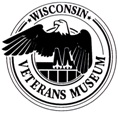Paul C. Winner Papers and Photographs
1911-1982
WVM Mss 1250
0.5 linear ft (1 archives box and three oversized folders) of papers, 1.0 linear ft. (3 archives boxes) of photographs.
Wisconsin Veterans Museum
(Map)
Papers and still images pertaining to the service of Paul Winner, a Madison, Wisconsin veteran who served as a pursuit pilot with the 213th Aero Squadron, 3rd Army of the American Expeditionary Force during World War I. Winner was a graduate student at Harvard University when he enlisted in the Army in 1917 to be trained as a pilot. After undergoing basic training he was sent to help construct the Third Aviation Instruction Center at Issoudun, France. Winner underwent flight training at Tours, France, but did not complete his training until after the end of the war. He served as part of the peacekeeping force in France until June, 1919. The collection documents his time serving in the Army through manuscript material and still images. The papers consist of letters, a diary, journal, flight log, service records, biographical information, newspaper articles, ephemeral souvenir items and identification cards, loose scrapbook pages, and a personal bible. The letters are mainly written by Winner to his parents and siblings during his time overseas in France. In the letters, Winner describes his journey over to England and France, his typical daily duties while stationed at Issoudun, his thoughts on the war, and interacting with French civilians. Most of the letters reassure his family that he is doing fine and getting plenty of rest and food. The letters also express concern for his family, with Winner regularly instructing his brother to stay in college rather than enlist in the Army. In a letter dated December 9th, 1917, he tells his brother to continue his study of medicine because that is the “best thing he could do for his country.” Also included with the letters are two written by Jeanne Dennett (Winner's future wife) to Winner's sister, Mae. In the letters, Jeanne describes the letters Winner wrote to her and expresses concern for his safety. Winner's diary, written on loose sheets of paper, provides entries that begin with his journey to Europe and end in March, 1918. He describes his arrival at Issoudun, helping to construct the airfield and barracks, and mentions the hardships of military life. Winner goes into detail about the cold temperatures, getting little to no food, serving on guard duty, having to deal with ankle-deep mud around the entire airbase, and witnessing airmen dying from airplane crashes and exposure to the elements. He mentions the low morale among the men due to the fact they were not being trained as pilots. Winner also describes how he witnessed Eddie Rickenbacker crashing a plane during a landing, and how Quentin Roosevelt served as his commanding officer for a time. The diary also briefly describes his first flight after he began training as a pilot. In an entry dated March 22, 1918, Winner describes in great detail his first flying experience and his enjoyment of actually being able to fly. The diary abruptly ends after Winner received an actual diary from his sister at the end of March. This diary is not in the collection. The collection also includes a notebook journal, which Winner kept notes from his training. An interesting entry in the journal includes a note about the number of French women infected with venereal disease. The flight log provides additional details into the training Winner received as a pilot and records flight hours, first solo flight, and descriptions of aerial maneuvers. His service records include special orders and mention him being promoted from private to 1st lieutenant when he began training as a pilot. The loose scrapbook pages contain additional service records, along with additional photographs of Winner posing in flight gear. The newspaper articles are clippings pertaining to U. S. airmen, presumably collected by Winner's mother while he was in France, and includes an interesting article about airmen serving at Issoudun from 1917. Still images include a large collection of photographs and postcards documenting Winner's service during the war and various cities he visited as a tourist. Most of the wartime photographs are labeled and include a lengthy description for context. The majority of photographs are of Winner and fellow airmen relaxing around bases and touring Europe after the war. An interesting group of images include those taken at Issoudun that show it in various stages of its construction. Other images consist of shots of destruction along the front line and within French towns, a funeral for two American pilots, German prisoners posing at the prison camp at Issoudun, and images of airplanes used during the war. After the war, Winner remained as part of the peacekeeping force and toured various cities across Europe. There is a large collection of tourist photographs that show Winner and other soldiers in European cities such as Paris, Marseilles, and Rome. The postcards include those collected by Winner while traveling across Europe after the war.
English
http://digital.library.wisc.edu/1711.dl/wiarchives.wvm-mss01250 ↑ Bookmark this ↑
